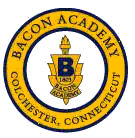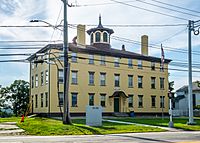Bacon Academy facts for kids
Quick facts for kids Bacon Academy |
|
|---|---|
 |
|
| Address | |
|
611 Norwich Ave
, Connecticut
06415
United States
|
|
| Coordinates | 41°34′28″N 72°18′10″W / 41.5745°N 72.3029°W |
| Information | |
| Established | 1803 |
| CEEB code | 070110 |
| Principal | Amy Begué |
| Grades | 9-12 |
| Enrollment | 759 (2018–19) |
| Mascot | Bobcats |
Bacon Academy is a public high school located in Colchester, Connecticut, USA. It was founded thanks to a generous gift from a farmer named Pierpont Bacon. He passed away in 1800 and left money to start a school.
His gift was meant to help the people of Colchester. It was for "supporting and maintaining a school…for the instruction of Youth in Reading and writing English, in Arithmetic, Mathimaticks, and the Languages, or such other branches of Learning." This school, named Bacon Academy, opened its doors on November 1, 1803. It has been helping young people learn and grow ever since.
Contents
History of Bacon Academy
In its early years, Bacon Academy was known for preparing students well for college. Local children could attend the school without paying tuition. Many important people in the 1800s thought highly of the Academy.
School Year and Student Life
The school year used to have three terms. The first term was from September to December. The second ran from January to April. The third term was from May to August. Records show that fewer local students attended during planting and harvesting seasons. Many would skip terms or leave early to help their families.
Early Bacon students did not get a diploma or graduate after four years. Instead, the school had three different learning levels, called branches. In the first branch, students learned subjects like languages, English grammar, and mathematics. The second branch taught writing, geometry, and public speaking. The last branch was like a common or elementary school. A student's age did not decide their level. Some students finished all three branches and left Bacon Academy by age fifteen or sixteen.
In 1886, the school changed to the four-year system we know today. By 1890, the first modern graduation ceremony was held. Each student who completed their studies received a diploma.
Daily Routines and Rules
The school bell would ring early in the morning. This was at 5:30 AM during the first and third terms. In winter, it rang at 7:00 AM for students in the first two branches. Each day, two students would practice public speaking in front of their teachers and classmates. After the speeches, the school day began with a Morning Prayer. The preceptor, who was the school's principal, would then talk about good behavior and studies. This routine changed after 1846. After that, bells only rang to signal the start of the school day.
Life as a Bacon student was strict. Students were expected to be honest and behave like gentlemen or ladies. They had to act properly and dress neatly, both in and out of class. If they did not, they could face punishment. This could include a warning, correction, or even expulsion. In class, students sat quietly at their desks. They studied classic texts in Greek or Latin. At home, students usually studied when they were not working on their family farms or doing chores.
Moving to New Buildings
After its 100th anniversary, the school's national fame lessened. Bacon Academy then mainly served students from Colchester and nearby towns. Over time, it became the public high school for Colchester. By 1962, the old building on Main Street was too small for all the students. They moved to a new school next to the grammar school.
The number of students grew a lot in the 1980s. This led to the building of an even newer high school. This current building opened in 1993, less than a mile east of the previous one.
In 2003, Bacon Academy celebrated its 200th anniversary. The celebration started with a special concert by the Bacon Academy Bands. Other events included a reunion for all past students, a golf tournament, and open houses at all the buildings that had ever housed the Academy.
Sports at Bacon Academy
The Bacon Academy sports teams are called the Bobcats. They are part of the Eastern Connecticut Conference (ECC).
Football Rivalry
The Bobcats have a big rivalry with RHAM High School in Hebron, Connecticut. The two schools play a football game every year on Thanksgiving Day. The winner receives "The Rail." This is a piece of railroad track. It represents the Airline Rail that used to connect the towns of Colchester and Hebron.
Girls' Basketball Success
On March 17, 2012, the varsity girls' basketball team won the Class L State Championship. They beat top-seeded E.O. Smith 38-34 at Mohegan Sun Arena. Their head coach, Dave Shea, was a Bacon Academy graduate from 1952. This win was his 660th career victory. The girls' basketball team also finished third in Connecticut in the final 2012 New Haven Register State Poll.
On March 15, 2025, the varsity girls' basketball team won the Class M State Championship. They defeated Windham High School 39-25 at the Mohegan Sun Arena. Head Coach Kevin Fennel's strong 3-2 zone defense helped them win the final and throughout the state tournament. The 2024-2025 team finished their season with 25 wins and 2 losses. They had an 18-game winning streak. This streak helped them win the Eastern Connecticut Conference (ECC) Division II title. They also won the ECC post-season tournament championship against Norwich Free Academy, and finally, the State Championship.
Girls' Soccer Championship
On November 18, 2023, the varsity girls' soccer team won their first Class M State Championship. They had a 2-1 victory over previously undefeated Suffield High School. The game was tied after regular time and overtime. It then went to three rounds of penalty kicks. Elizabeth Glover, the Junior Goal Keeper for Bacon Academy, made the winning kick. She was named MVP of the State Tournament.
Famous People Who Attended Bacon Academy
- Stephen F. Austin — Known as the "father of Texas"
- William Alfred Buckingham — A former Governor and Republican Senator for Connecticut
- Eliphalet Adams Bulkeley — The first president of Aetna Insurance Company
- Morgan Bulkeley — A former Mayor of Hartford, Governor of Connecticut, and Republican Senator for Connecticut. He is also a member of the Baseball Hall of Fame.
- J. Cleaveland Cady — A famous architect
- Jonathan Coulton — An American singer-songwriter
- William J. Johnston — Received the Medal of Honor, the highest military award in the United States
- Edwin D. Morgan — A former Governor of New York and U.S. Senator
- Lewis E. Stanton — A United States Attorney for the District of Connecticut
- Lyman Trumbull — A U.S. Senator of Illinois and helped write the Thirteenth Amendment to the United States Constitution
- Morrison Remick Waite — A Supreme Court Justice
- Ron Wotus — A Major League Baseball player and former coach for the San Francisco Giants
- Arthur Williams Wright — Received the first PhD in science granted outside Europe while studying at Yale University



